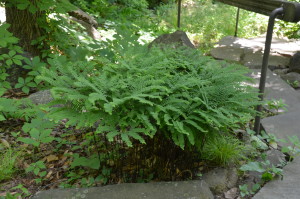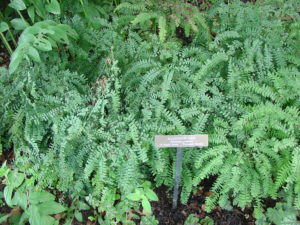Maidenhair ferns (Adiantum spp.) are deciduous hardy perennial ferns. Two native species are commonly planted in U.S. gardens. These delicate-looking ferns typically grow 1 to 2 feet tall and frequently grow in rich soils in eastern and Midwest U.S. woodland gardens.
The palmately compound fronds are finely-textured along with thin wiry black stems. Coiled young fiddleheads (crosiers) emerge with a pinkish tint in spring.
Northern or Common Maidenhair (A. pedatum) grows 10 to 26 inches tall on thin, wiry stems (USDA hardiness zones 3-8). On older plants fronds develop in a distinctive horseshoe or crab framework. It is deciduous and grows in part to full shade in the mountains and piedmont regions.
Southern or Venus Maidenhair (A. capillus-veneris) grows 12 to 24 inches tall on thin wiry stems with delicate leaves (USDA hardiness zones (6)7-10). It will tolerate zone 6 winters in Virginia, Kentucky and Tennessee if dormant clumps are grown in dappled shade and sheltered from dry wintry winds.
Maidenhair ferns grow in average, medium, well-drained soil in partial to full shade. Clumps flourish in moist, humus-rich, in neutral to alkaline (high calcium) moist soils. Maintain moist cool soils with generous amounts of mulch or pine needles. In their northerly range, maidenhair ferns will prosper in 1-2 hours of morning sunlight, but dappled light in southern climes is adequate.
Despite their lacey appearance, maidenhair ferns are tough, easy-to-grow shade perennial ferns that are free of serious insect or disease problems and are deer resistant. By late summer, summer heat sometimes scorches the thin tender fronds, especially if soil moisture levels are inadequate and/or plants receive too much sunlight.
Maidenhair ferns are perfect for rock gardens, or in mixed container arrangements. Plants spread slowly by creeping, branching rhizomes to eventually form large colonies.
For accent, combined them with broad leaves of small leaved hostas, coral bells (Heuchera), lungworts (Pulmonaria), and fairy wings (Epimedium).



 Posted in
Posted in 
